Presented at the "First International Conference" of CRN Child Science Exchange Program in Asia held in Shanghai, China, March 4-5, 2017.
Moderator: Lili Ma (President of Hua Xia Future Early Childhood Education Group)
Presenters: Donghua Chen (Professor, Tianjin Normal University), Lee-Fong Wong (Professor, National Taipei University of Education), Yi Zheng (Speical-Grade Teacher of Shanghai, Senior Researcher of Education)
Physical Education That Is Scientific, Normative, Safe, Effective and Enjoyable at Kindergartens with Unique Chinese Characteristics (Donghua Chen)
At kindergartens with unique Chinese characteristics, it is necessary to conduct physical training and education, and at the same time, fully enhance developmental functions. We should provide physical education that develops young children's body motions, accelerates their growth and strengthens their physical quality. Furthermore, physical education should comprehensively promote children's personal, wisdom, psychological, aesthetic and social developments.
However, what is physical quality? The term "physical quality" in the context of children refers to their physical constitution, physical performance and adaptability. A physical performance includes physical capabilities and movements. Nowadays, only the physical performance tends to be emphasized, and as a result the physical constitution is undervalued. Physical education is provided without considering each child's physical constitution, growth and development. Poor posture in children is also overlooked. Kindergartens should design their physical education programs considering the purposes, planning processes and structures of the programs, undertaking various proactive exercises according to the age of the children. Nevertheless, a lot of the physical activities which children are currently engaged in are not suitable for their age group. For example, we often see children doing roller-skating or playing street basketball games across the country, but these sports are not for every child. The role of physical education is significant in supporting children's development. The most important thing is to build up their body and make them healthy. Every organ system is strengthened by exercise, which improves the heart and lung functional rates, and hence, the function of each organ system will be developed and enhanced. However, it is important to conduct such exercise in a scientifically effective way, otherwise, it will impose a strain on their cardiovascular system.
Exercise can create a favorable physical foundation necessary for the development of children's intellectual capabilities. This stage is important for brain development, and is directly related to physical fitness. The number of dendrites and the speed of information transmission in the nervous system are deeply linked to exercise.
Physical education is also important for children's emotional development. They observe the demonstration by teachers, develop a sense of rhythm, feel the beauty of movement, and thus learn to create beauty by themselves. The definition of beauty is intentionally broad here, covering notions such as realistic beauty, social beauty, natural beauty, physical beauty, the beauty of motions, the beauty of willpower and character, the beauty of architecture or facilities, and the beauty of clothing. Physical activities at kindergartens have significant meanings and roles necessary for the entire development of the children's bodies, minds and moral virtues. Therefore, the importance of physical education should never be underestimated.
Kindergartens should provide physical activities based on the principle of education at both collective and individual levels, by combining main group lessons with individual free practice. Instructions are needed at the kindergarten level, especially in physical education, where children should be taught how to move in physical activities. If they are not taught how to exercise, children will never understand how to move. For example, teachers need to demonstrate how to jump high or far, leap, etc. If teachers do not provide example performances, children may think by themselves and acquire wrong techniques. It is difficult to rectify incorrect movements once they have been acquired. Therefore, teaching physical activities is indispensable.
Teaching exercise should be conducted through group lessons, by clearly informing children what is expected of them and what they should be doing, specifically. Teachers need to instruct and teach children flexibly, respecting their independence and giving individual attention to each child. Therefore, they should carefully plan how to teach in advance and appropriately perform their guidance. Then, teachers help children exercise what they learn in their daily outdoor activities. Teaching and exercising are inseparable.
Kindergartens should provide physical activities appropriate to the growth and developmental characteristics of each child. Inappropriate exercise may damage children's health and even cause injuries in the worst cases. Furthermore, physical activities should be designed based on scientific facts and conducted in a scientific and orderly manner from easy activities to difficult ones and from low-motions to high-motions. Teachers should provide not only children's favorite activities but also the education necessary for them. They need to teach children to be brave, strong, united and cooperative, and comply with rules. The methods of activities vary. Teachers should determine the content and priority order of activities based on scientific grounds, by rationally utilizing various methods and approaches. More importantly, they should set rules for transitions between each stage in a class and carefully conduct such transitions. Teaching should be tied to learning in various formats, not just in a single format. Good physical education can be achieved by linking the interesting aspects of physical activities with their educational aspects, providing children with enjoyable and entertaining exercise programs while building their bodies and enhancing their knowledge and physical capabilities.
Physical education at kindergartens with unique Chinese characteristics should aim to inherit and promote the traditional culture of Chinese people, fully reflecting the essence of the ethnic and national sports of the nation. The Minister of Education Chen Baosheng spoke at the Lianghui (the National People's Congress and the Chinese People's Political Consultative Conference) about the development of school culture and mentioned China's traditional sports such as the martial arts and Tai Chi. It is necessary to conduct physical activities with high goals. Such high goals should be set according to the development stage of children's bodies and minds, such as their physical level, environment and condition.
Given the above, physical education at Chinese kindergartens should effectively maintain the functions of physical health, education and development. It should be conducted through group lessons combined with individual free practice. Physical education should be aimed to inherit and promote the traditional culture of Chinese people and conducted in a manner that is scientific, normative, safe, effective and enjoyable.
Designing Outdoor Exercise at Kindergartens: Actual Conditions of Kindergartens in Taipei and Tokyo (Lee-Fong Wong)
In 2012, the government of Taiwan consolidated nurseries and kindergartens into a single category named "preschool institutions." At the same time, the Early Childhood Education and Care Act, together with related regulations, were enacted.
The act sets forth the provision of appropriate environment and educational activities according to the development stage of children; the enhancement of children's capabilities in terms of physical movements, language, cognitive skills, aesthetic sense, emotions and human relationships; and the fostering and promotion of basic life skills, satisfactory life habits, and aggressive learning attitudes.
This new act also sets forth the "preschool evaluation" provision, the system that Taiwan preschool teachers most fear. Both public and private preschools are afraid of this evaluation system. All children aged five or above can go to preschool with government assistance. The monthly fees of private preschools ranges from 20,000 New Taiwan Dollars to 30,000 New Taiwan Dollars (approximately 680-1,020 US dollars), while the monthly fee of public preschools is about 5,000 New Taiwan Dollars (less than 170 US dollars). Any preschool that fails to satisfy the regulatory standards as a result of the above-mentioned evaluation will not receive any subsidy from the government. In such cases, the parental financial burden will be increased.
The environments and facilities of public preschools are almost the same, regardless of whether they are located in an urban area or in a village of indigenous inhabitants in the mountains. The Xinyi Preschool we introduce here is located in the Xinyi District of Taipei where the land prices are the highest in Taiwan. Many visitors in Taipei visit TAIPEI 101, a skyscraper in the Xinyi District. However, because the Xinyi Preschool is publicly run, the monthly fee of the preschool is quite low, like other public preschools in Taipei. All public and private preschools should have a playground and preschool teachers are obligated to record the activities of each child every day. I often wonder when these teachers can find the time to play with children if they are obliged to record their activities every day.
In fact, kindergartens in mainland China and Taiwan started off by imitating Japanese kindergartens a century ago. This is why we need to compare Taiwanese kindergartens with Japanese kindergartens. We will introduce one private kindergarten in Tokyo, which is not a special kindergarten. When we visited it, we saw about one hundred children. The basic concept of Japanese kindergartens is to let children experience nature: their indoor activities are often linked to outdoor activities. For example, playing with a Koma (a traditional Japanese toy) is one of the indoor activities at kindergartens, but children also play with a Koma outside (Figure 1). Teachers plan the activities specific for children aged three, four and five, respectively. Children sometimes enjoy camping at night, bringing out indoor tools and eating outside. It is like a picnic.
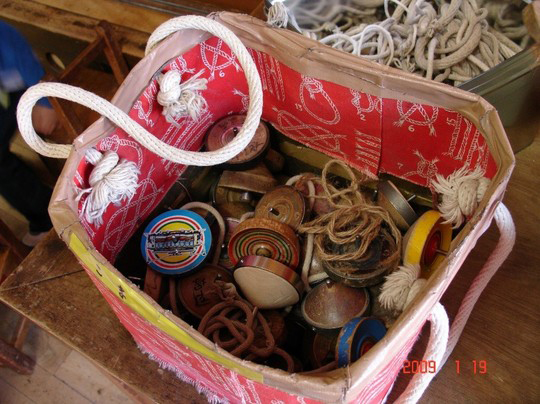
Figure 1
If children at kindergartens in urban cities want to swim, what can we do? Most Japanese kindergartens use a portable swimming pool (a folding plastic pool) in summer. Most Taiwanese teachers consider it dangerous if a child climbs a tree, while Japanese teachers do not. Expensive climbing playsets are not always used in Japan, but there are natural big trees, sand boxes, small cabins, etc.. Children love to play with them (Figure 2).
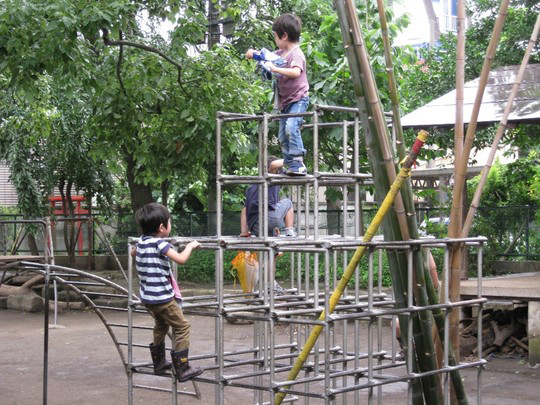
Figure 2
Taiwanese teachers teach a large number of things but rarely teach how to exercise. Most parents are of the opinion "Children do not need to play more. If they want to play, they can play at home." In this regard, there is a considerable difference between Japanese kindergartens and Taiwanese kindergartens. As has always been said, a kindergarten should be a paradise where children can play. We, teachers in Taiwan, say so too, but there is still a big gap between conditions in Taiwan and those in Japan.
Practical Study on the Environmental Design of Free-Choice Exercise by Children of Mixed-Age Groups (Yi Zheng)
There are three characteristics of free-choice exercise by children of different age groups at kindergartens. The first is "enjoyment." Kindergartens provide free-choice exercise completely based on children's interests and all children perform their free-choice exercise independently. Children are not examiners but participants; therefore, they do not have to worry, fear or be frustrated with their performance and thus experience no psychological pressure. The second is "openness." Free-choice exercise is "spatially open" for 45 minutes and children can freely choose their activity. Children can freely move from one corner to another, cooperate with their peers, and learn how to comply with activity rules. The third is "holistic-ness." Free-choice exercise places emphasis on the holistic aspect. Children choose their exercise, for which various activities are incorporated in different ways. Therefore, the development of children's motion is relatively holistic. In addition, children will experience various exercises in such activities and improve their ability to protect themselves. Therefore, free-choice exercise, among other types of exercise, can enhance the holistic-ness of children's development, in particular, the development of their autonomy and social skills.
We will explain some points to consider regarding the practice of free-choice exercise. The first is time allocation. We conduct free-choice exercises for about 45 minutes in the morning once a week. Some kindergartens place a particular emphasis on exercises they may conduct two or three times a week. We also make adjustments to the environment of free-choice exercises according to seasonal changes and children's interest. The second is formats. Fundamentally, we classified free-choice exercises into three categories. The first is conducted on a classroom basis, helping children gain their understanding of the basic environment of the kindergarten, materials, compliance with rules, behavior, routes, etc. The second is conducted on a grade basis. We offer eight classes for the five-year-olds of the kindergarten. These children can freely choose activities set for each of the eight classes. Likewise, nine classes are offered for the six-year-olds of the kindergarten and children can freely choose activities set for nine such classes. The third is conducted on a mixed-age group basis. Children of different ages can learn and experience a great many new methods and play activities.
With respect to locations, the planner should reasonably allocate the number, content, and scene of activities to appropriate locations considering the environment of each kindergarten, because each place has different room arrangements. Then, how are free-choice exercises designed? We propose the following procedures. First, we design free-choice exercises based on movements. The current guidelines for preschool education curriculum in Shanghai describe 17 movement skills, expanded from the conventional movements of "walking, running, jumping, balancing, ducking, crawling, and throwing." The additional movements include hanging, pushing, pulling, pitching and catching. The purpose of these movements is to ensure the necessary development of each part of the body such as the waist. Therefore, when determining physical activities, we need to consider how to effectively reflect these 17 movement skills in free-choice exercises. Second, we design free-choice exercises based on physical capabilities. According to some studies, it is possible to choose one physical capability and develop other capabilities simultaneously, considering the speed of children's learning of physical capabilities.
Next, we should consider the compliance of rules. In free-choice exercises, awareness towards the compliance of rules is considered very important, while children's autonomy is respected. Therefore, it is necessary to clearly show the route of each child from the beginning to the end in free-choice exercises. Now, we will suggest some specific ideas regarding the allocation and concept of physical activities for children. First, to design free-choice exercises which are interesting for children. We can determine themes, stories and missions to achieve in free-choice exercises, which will motivate children to challenge them. Activities can be more and more enjoyable if we always consider the development level of children and offer various scenes of choices for them. It is also important to ensure the variety of materials by adding supplementary tools. Materials should be simple, interesting and effective. We should consider and study how to add and use simple materials in the kindergarten, which will make children happy and increase their usage of such materials.
Second, to design a challenging environment for free-choice exercises. We should leverage the function of play by letting children discover and solve a problem by themselves through exercises. In this way, children can gain knowledge on exercises and develop their problem-solving and thinking skills.
The first challenge to consider is one for physical capabilities. For example, we should set the appropriate target height of a high-jump bar for the four-year-olds, five-year-olds and six-year-olds of kindergarten, respectively, which will give them a challenging and meaningful target. The second is a challenge for experiences. Each child (even for children of the same age group) has a different development speed of physical capabilities. This gap is more remarkable for younger children of different ages in month. Therefore, we should carefully set a target with different levels of difficulty. For children of the mixed-age group, we need to pay special attention to set a target for each level of physical capability, considering each child's experiences and age differences.
The final challenge is for mental capabilities. This requires children's autonomy most in free-choice exercises, which makes it difficult for teachers to instruct children. When teachers wish to foster children's challenging behavior, they should closely observe and communicate with them. In this way, teachers can gradually gain experience and obtain some ideas how to develop their mental capabilities.



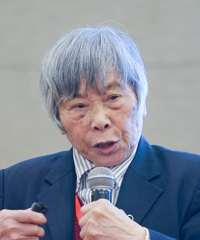 Donghua Chen
Donghua Chen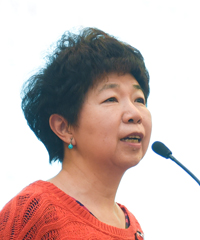 Lee-Fong Wong
Lee-Fong Wong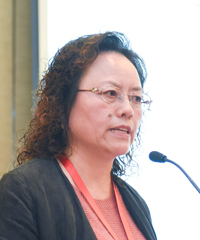 Yi Zheng
Yi Zheng










